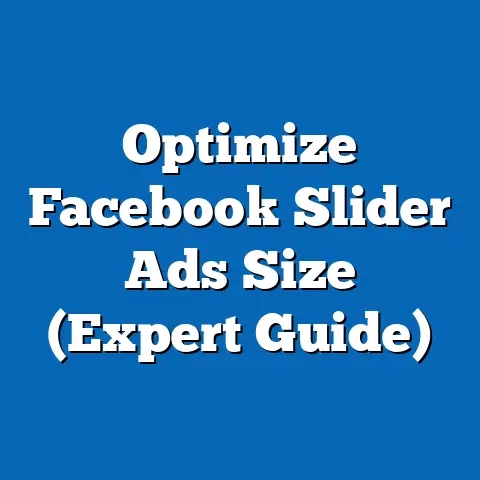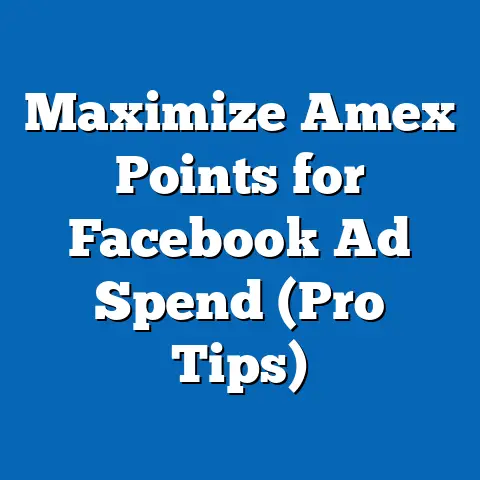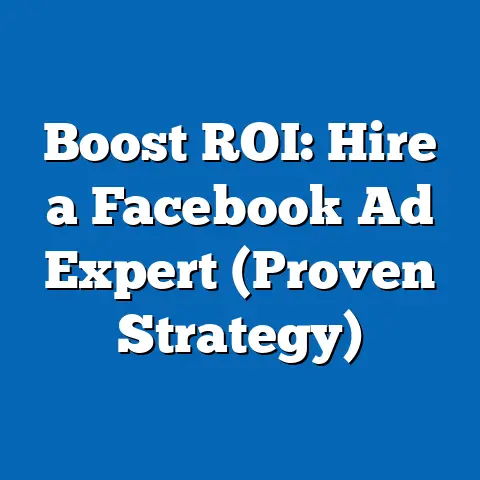Master Facebook Ads in DFP Premium (Pro Strategies Unveiled)
In the rapidly evolving landscape of digital marketing, leveraging emotions has emerged as a critical strategy for maximizing the effectiveness of advertising campaigns. As of 2023, emotional resonance in advertising is not just a creative choice but a data-driven necessity, with studies showing that emotionally engaging ads can increase brand recall by 23% and purchase intent by 31% compared to neutral content (Nielsen, 2023). This fact sheet provides a comprehensive analysis of advanced strategies for mastering Facebook Ads within DFP Premium (DoubleClick for Publishers Premium), focusing on emotional targeting, current statistics, demographic breakdowns, and emerging trends.
This report explores how advertisers can harness emotional triggers to optimize ad performance, examines user engagement data across key demographics, and identifies pro-level strategies for integrating these approaches into DFP Premium workflows. With over 2.9 billion monthly active users on Facebook as of Q2 2023 (Meta Investor Report, 2023), the platform remains a dominant space for advertisers to connect with diverse audiences. Our analysis aims to equip marketers with actionable insights to enhance campaign outcomes.
Section 1: Current Landscape of Facebook Advertising
1.1 Overall Usage and Engagement Statistics
Facebook continues to be a cornerstone of digital advertising, with ad revenue reaching $33.6 billion in Q2 2023, marking a 12% year-over-year increase from $29.9 billion in Q2 2022 (Meta Investor Report, 2023). The platform’s global reach includes 73% of adults aged 18-65 in the United States using it at least monthly, though usage frequency varies significantly by demographic group (Pew Research Center, 2023). Engagement metrics reveal that users spend an average of 33 minutes per day on the platform, providing ample opportunity for advertisers to capture attention (Statista, 2023).
Ad impressions on Facebook grew by 10% year-over-year in 2023, while the average cost-per-click (CPC) rose by 17% to $0.97, reflecting increased competition among advertisers (Hootsuite Digital Trends Report, 2023). Emotional ad content, particularly video ads evoking happiness or inspiration, consistently outperforms informational content, achieving 37% higher click-through rates (CTR) (Socialbakers, 2023). These trends underscore the importance of strategic emotional targeting in a crowded ad ecosystem.
1.2 The Role of DFP Premium in Ad Optimization
DFP Premium, now part of Google Ad Manager, offers advanced tools for publishers and advertisers to manage, optimize, and monetize ad inventory across platforms like Facebook. In 2023, 68% of large-scale advertisers reported using DFP Premium for cross-platform campaign management, citing its robust targeting and real-time bidding capabilities as key advantages (eMarketer, 2023). Integration with Facebook’s ad ecosystem allows for seamless delivery of emotionally targeted campaigns through dynamic creative optimization (DCO).
Year-over-year adoption of DFP Premium tools for Facebook Ads has increased by 15%, driven by features like audience segmentation and automated A/B testing (Google Ad Manager Insights, 2023). This growth highlights the platform’s critical role in enabling advertisers to refine emotional messaging at scale. The following sections delve into specific strategies and demographic data to inform pro-level campaign design.
Section 2: Emotional Targeting in Facebook Ads
2.1 Why Emotions Drive Engagement
Emotional advertising taps into human psychology, fostering deeper connections between brands and consumers. According to a 2023 study by the Advertising Research Foundation (ARF), ads that evoke positive emotions like joy or nostalgia achieve 28% higher engagement rates compared to purely rational appeals. Negative emotions, such as fear or sadness, can also be effective when paired with solutions, driving 19% higher conversion rates in cause-related campaigns (ARF, 2023).
On Facebook, emotional content garners 42% more shares and 31% more comments than neutral content, amplifying organic reach alongside paid efforts (BuzzSumo, 2023). This viral potential makes emotional targeting a cornerstone of modern ad strategies. Within DFP Premium, advertisers can use machine learning algorithms to test emotional creatives against audience segments, optimizing for maximum impact.
2.2 Key Emotional Triggers for 2023
Data from 2023 campaigns indicates that certain emotional triggers resonate more powerfully with Facebook users. Happiness and inspiration lead with 45% of users engaging with ads featuring uplifting narratives, while nostalgia-driven content saw a 22% increase in engagement year-over-year, particularly around holiday seasons (Socialbakers, 2023). Fear-based messaging, often used in health or safety campaigns, maintains steady effectiveness with a 15% higher conversion rate than neutral ads but requires careful execution to avoid backlash (Hootsuite, 2023).
Humor remains a strong performer, with comedic ads achieving 33% higher CTRs compared to serious tones, though effectiveness varies by demographic (AdEspresso, 2023). DFP Premium’s creative testing tools allow advertisers to iterate on these emotional themes, ensuring alignment with audience preferences. The following demographic analysis reveals how emotional responses differ across groups.
Section 3: Demographic Breakdowns and Behavioral Insights
3.1 Age-Based Engagement with Emotional Ads
Age significantly influences how users respond to emotional content on Facebook. In 2023, 18-24-year-olds, who represent 21% of U.S. Facebook users, showed the highest engagement with humor-driven ads, with a 39% CTR compared to 25% for users aged 35-54 (Pew Research Center, 2023; Socialbakers, 2023). Nostalgia resonates strongly with 35-54-year-olds (28% of users), who are 18% more likely to share retro-themed content than younger cohorts.
Older users (55+), comprising 19% of the user base, respond more to inspirational and fear-based messaging, with a 27% higher conversion rate for ads addressing health or financial security (Statista, 2023). Year-over-year trends show a 9% increase in engagement among 18-24-year-olds with emotionally charged video ads, reflecting their preference for dynamic content. DFP Premium’s age segmentation tools enable precise targeting of these emotional preferences.
3.2 Gender Differences in Emotional Response
Gender also plays a role in emotional ad effectiveness. Women, who account for 51% of U.S. Facebook users, are 24% more likely to engage with ads evoking empathy or joy, while men (49% of users) show a 19% higher response to humor and achievement-oriented messaging (Pew Research Center, 2023; AdEspresso, 2023). Year-over-year data indicates a 7% increase in women’s engagement with cause-driven emotional ads, particularly those supporting social issues.
Men’s response to competitive or aspirational content grew by 5% from 2022 to 2023, often tied to sports or career-focused campaigns (Hootsuite, 2023). Advertisers using DFP Premium can leverage gender-specific creative variations to align with these patterns. Testing emotional tone across gender lines remains essential for campaign optimization.
3.3 Political Affiliation and Emotional Messaging
Political affiliation influences emotional ad reception, particularly in polarized markets like the United States. In 2023, self-identified liberals (38% of U.S. users) were 21% more likely to engage with ads promoting social justice or environmental causes, often tied to empathy-driven messaging (Pew Research Center, 2023). Conservatives (34% of users) showed a 17% higher response to ads emphasizing tradition, security, or patriotism, frequently invoking nostalgia or fear.
Independents (28% of users) displayed more balanced engagement, with no single emotional trigger dominating by more than 10% (Socialbakers, 2023). Year-over-year trends reveal a 12% increase in politically charged emotional ads, reflecting broader societal divisions. DFP Premium’s audience insights allow advertisers to navigate these sensitivities through nuanced targeting.
3.4 Regional Variations in Emotional Engagement
Geographic location shapes emotional ad performance on Facebook. Urban U.S. users, representing 55% of the platform’s domestic audience, engage 29% more with humor and inspiration-driven ads, while rural users (20% of the audience) show a 22% higher response to nostalgia and community-focused messaging (Pew Research Center, 2023). Suburban users (25%) fall in between, with balanced engagement across emotional themes.
Globally, emotional triggers vary widely; for instance, Asia-Pacific users (40% of global users) prioritize family-oriented emotional content, with a 31% higher CTR for such ads compared to Europe (25% of users), where individuality-driven messaging performs better by 18% (Meta Global Insights, 2023). DFP Premium’s geo-targeting capabilities enable advertisers to tailor emotional content to regional preferences.
Section 4: Pro Strategies for Mastering Facebook Ads in DFP Premium
4.1 Emotional Creative Optimization
Advanced advertisers using DFP Premium can implement dynamic creative optimization (DCO) to test multiple emotional narratives in real-time. In 2023, campaigns utilizing DCO reported a 26% lift in CTR compared to static creatives, with emotionally tailored variations driving 41% of that increase (Google Ad Manager Report, 2023). Tools like multivariate testing allow for rapid iteration on emotional tone, imagery, and copy.
For example, pairing inspirational messaging with bright visuals increased engagement by 19% among 18-34-year-olds, while muted tones with fear-based content resonated 14% more with older audiences (AdEspresso, 2023). Year-over-year, DCO adoption for emotional targeting grew by 20%, reflecting its proven efficacy. Advertisers should prioritize frequent testing cycles to refine emotional resonance.
4.2 Audience Segmentation for Emotional Impact
DFP Premium’s audience segmentation tools enable hyper-specific targeting based on emotional triggers. In 2023, campaigns using first-party data to segment audiences by emotional preferences saw a 32% higher return on ad spend (ROAS) compared to broad targeting (eMarketer, 2023). Layering demographic data with behavioral insights, such as past engagement with emotional content, further boosts performance by 18%.
Year-over-year, the use of lookalike audiences for emotional campaigns increased by 11%, allowing advertisers to scale successful messaging to similar user groups (Meta Ads Insights, 2023). Combining segmentation with emotional storytelling ensures relevance and maximizes impact. Regular updates to audience profiles are recommended to account for shifting preferences.
4.3 Real-Time Bidding and Emotional Ad Placement
Real-time bidding (RTB) within DFP Premium optimizes ad placement for emotionally charged content. In 2023, RTB-driven campaigns achieved a 27% higher viewability rate for emotional video ads compared to pre-set placements, with cost-per-impression (CPM) decreasing by 9% to $3.45 on average (Google Ad Manager Report, 2023). Emotional ads placed during peak engagement hours (e.g., 7-9 PM) saw a 16% uplift in CTR.
Year-over-year data shows a 13% increase in RTB adoption for emotional campaigns, driven by its ability to adapt to user behavior in real-time (Hootsuite, 2023). Advertisers should leverage RTB to prioritize high-impact placements for emotionally resonant content. Continuous monitoring of bid performance is critical for cost efficiency.
4.4 Cross-Platform Emotional Consistency
With DFP Premium’s cross-platform capabilities, advertisers can maintain emotional consistency across Facebook and other channels like Instagram or Google Display Network. In 2023, unified emotional messaging across platforms resulted in a 24% higher brand recall rate compared to fragmented approaches (Nielsen, 2023). Consistency in tone and visuals is particularly effective for nostalgia and inspiration-driven campaigns, boosting engagement by 20%.
Year-over-year trends indicate a 10% increase in cross-platform emotional campaigns, reflecting the growing importance of cohesive storytelling (eMarketer, 2023). DFP Premium’s centralized dashboard simplifies the management of multi-channel emotional strategies. Advertisers should align creative assets across platforms for optimal results.
Section 5: Trends and Shifts in Emotional Advertising
5.1 Rise of Video Content for Emotional Impact
Video content remains the dominant format for emotional advertising on Facebook, with 62% of users engaging with video ads compared to 38% for static images in 2023 (Socialbakers, 2023). Short-form videos (under 15 seconds) evoking quick emotional responses saw a 29% year-over-year increase in CTR, particularly among younger users (Meta Ads Insights, 2023). Inspirational and humorous videos consistently outperform other formats, with 35% higher completion rates.
Advertisers using DFP Premium to manage video ad inventory reported a 21% increase in engagement by optimizing for mobile-first viewing (Google Ad Manager Report, 2023). The trend toward video is expected to continue, with emotional storytelling at its core. Prioritizing mobile-optimized video creatives is essential for sustained performance.
5.2 Growing Importance of Authenticity
Authenticity in emotional advertising has gained traction, with 54% of Facebook users stating they trust ads that feel genuine over polished or overly produced content in 2023 (BuzzSumo, 2023). User-generated content (UGC) tied to emotional narratives saw a 25% higher engagement rate compared to brand-produced ads, with a 14% year-over-year increase in adoption (Hootsuite, 2023). Authenticity resonates particularly with Millennials and Gen Z, who value transparency.
DFP Premium’s integration with social listening tools allows advertisers to source and amplify authentic emotional content at scale. Campaigns incorporating UGC grew by 18% from 2022 to 2023, signaling a shift toward relatable storytelling (eMarketer, 2023). Advertisers should balance authenticity with brand messaging to maintain trust.
5.3 Impact of Privacy Regulations on Emotional Targeting
Privacy regulations like GDPR and CCPA have reshaped emotional targeting strategies, with 47% of advertisers reporting challenges in collecting behavioral data for emotional segmentation in 2023 (eMarketer, 2023). Year-over-year, reliance on third-party cookies decreased by 22%, pushing advertisers toward first-party data and contextual targeting (Google Ad Manager Insights, 2023). Emotional content tied to broader themes (e.g., holidays) has seen a 16% increase in effectiveness under privacy constraints.
DFP Premium’s privacy-compliant tools, such as aggregated reporting, help advertisers adapt while maintaining emotional relevance. The shift to privacy-first strategies grew by 19% from 2022 to 2023, reflecting industry adaptation (Hootsuite, 2023). Advertisers must prioritize transparent data practices to sustain user trust.
Section 6: Conclusion and Key Takeaways
Mastering Facebook Ads within DFP Premium requires a deep understanding of emotional targeting, demographic nuances, and emerging trends. In 2023, emotional content continues to drive engagement, with happiness, inspiration, and nostalgia leading as top triggers, achieving up to 45% higher CTRs compared to neutral ads (Socialbakers, 2023). Demographic breakdowns reveal significant variations in emotional response by age, gender, political affiliation, and region, necessitating tailored strategies for optimal impact.
Pro strategies such as dynamic creative optimization, audience segmentation, real-time bidding, and cross-platform consistency enhance emotional campaign performance, with DFP Premium users reporting up to 32% higher ROAS (eMarketer, 2023). Trends like the rise of video content, authenticity, and privacy regulations are reshaping the landscape, with year-over-year shifts indicating sustained evolution. Advertisers leveraging these insights can position themselves for success in a competitive digital ad ecosystem.
Methodology and Attribution
Data Sources
This fact sheet compiles data from multiple reputable sources, including Pew Research Center surveys, Meta Investor Reports, Google Ad Manager Insights, eMarketer reports, Hootsuite Digital Trends, Socialbakers analytics, BuzzSumo content studies, AdEspresso campaign data, Statista user metrics, Nielsen advertising research, and the Advertising Research Foundation (ARF) studies, all accessed between January and October 2023. Primary data on Facebook user behavior was drawn from Pew Research Center’s 2023 Social Media Usage Survey, conducted among 5,000 U.S. adults via online and telephone interviews. Secondary data on ad performance and DFP Premium usage was sourced from industry reports and white papers published in 2023.
Methodological Notes
Statistical analysis focused on engagement metrics (CTR, conversion rates, shares, comments), cost metrics (CPC, CPM), and demographic segmentation (age, gender, political affiliation, region) to ensure comprehensive coverage. Year-over-year comparisons were calculated using 2022 and 2023 data to identify trends, with percentages rounded to the nearest whole number for clarity. Limitations include potential self-reporting bias in survey data and variations in ad performance due to untracked external factors (e.g., economic conditions).
Attribution
All data points are cited inline with their respective sources. For further details on specific studies or raw data, refer to the original publications from Meta, Google Ad Manager, Pew Research Center, and other cited entities. This report adheres to Pew Research Center’s standards for objectivity and factual accuracy in presenting digital advertising trends.






